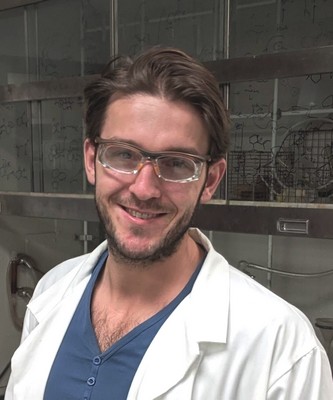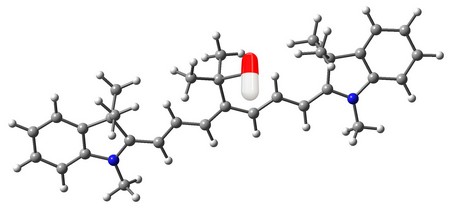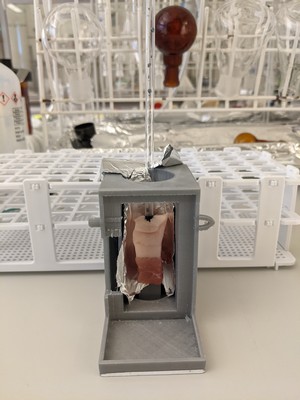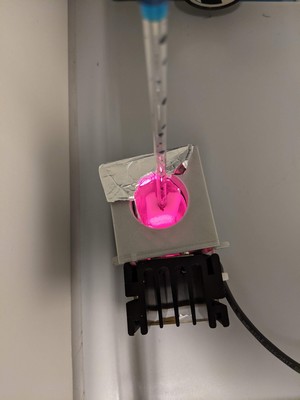Met licht gecontroleerd geneesmiddelentransport voor precisie-behandeling
Bij een behandeling tegen kanker verspreidt de chemotherapie zich door het hele lichaam van de patiënt, wat kan zorgen voor allerlei bijwerkingen in gezond weefsel. Onderzoekers van de RUG en het UMCG hebben eerder al geneesmiddelen ontwikkeld die met licht aan te zetten zijn op de plek waar ze nodig zijn. En nu hebben ze een ‘kooi’ ontwikkeld die met licht opengezet kan worden. De kooi is op een computer ontworpen en vervolgens gemaakt via synthetische chemie. Een publicatie over deze designer-kooi is op 19 februari gepubliceerd in het tijdschrift Angewandte Chemie als ‘Very Important Paper’.
Een ‘fotokooi’ is een moleculair stukje gereedschap om geneesmiddelen gericht af te leveren. Het zijn niet echt kooien of doosjes, maar grote moleculen die zich hechten aan het geneesmiddel. Dit gebonden middel is niet actief, totdat de kooi wordt bestraald met licht van de juiste golflengte (kleur), waarna het geneesmiddel wordt losgelaten en het zijn activiteit weer krijgt. ‘De uitdaging is om fotokooien te maken die reageren op nabij-infrarood licht, omdat dit veel beter in het lichaam doordringt dan UV- of zichtbaar licht’, legt George Alachouzos uit. Tot nu toe zijn zulke kooien ontwikkeld door bestaand kooien aan te passen zodat ze reageren op de juiste, infrarode, golflengte.

Elektronendichtheid
Tijdens zijn promotieonderzoek in organische chemie in de VS kreeg Alachouzos belangstelling voor op licht reagerende moleculaire schakelaars en kooien. ‘Ik bestudeerde publicaties uit de laboratoria van Ben Feringa en Wiktor Szymanski, over geneesmiddelen die met licht aangezet kunnen worden’, vertelt hij. Feringa is hoogleraar Organische Chemie aan de RUG en een van de ontvangers van de Nobelprijs voor chemie in 2016, voor zijn onderzoek naar een andere klasse door licht geactiveerde moleculen: door licht aangedreven motoren. Szymanski werkt al lang samen met Feringa en is associate professor aan het UMCG.
Tijdens het bestuderen van de literatuur over fotokooien viel Alachouzos iets op: het deel van de kooi van waar het geneesmiddel werd losgelaten leek steeds een bepaalde elektronische structuur te hebben. In alle kooien die beschreven zijn delen de atomen uit het molecuul een aantal elektronen. Alachouzos: ‘Dit betekent dat de dichtheid van de elektronen soms niet gelijk is verdeeld over het molecuul. De energie van het licht dat de kooi opent leek de elektronendichtheid te doen toenemen op het punt waar het geneesmiddel aan de kooi vast zit.’ Er verscheen een lob van elektronen die er eerder niet was. ‘De observatie is dat het ontstaan van zo’n elektronen-lob blijkbaar de verandering veroorzaakt die de kooi opent. Mijn hypothese was dat iedere kleurstof waarin deze verandering in de elektronenverdeling optreedt onder invloed van licht is te gebruiken als een fotokooi.’

Kandidaten
Hij nam contact op het Feringa en Szymanski en besprak dit idee. Samen schreven zij een subsidievoorstel dat werd toegekend door de European Molecular Biology Organization. Dit stelde Alachouzos in staat om naar Groningen te komen en daar zijn hypothese te testen. ‘Ik begon met het maken van een catalogus van kleurstoffen die nabij-infrarood licht absorberen. Daarna gebruikte ik de Peregrine supercomputer van het Centrum voor Informatietechnologie van de RUG, om te zien welke van die kleurstoffen onder invloed van nabij-infrarood licht zo’n lob vormden.’
Deze procedure leverde een aantal kandidaten op. Een ervan kwam uit een bekende familie van kleurstoffen die worden gebruikt in fluorescentie-experimenten in proefdieren en mensen, en zelfs in ziekenhuizen: Cy7. ‘Dit molecuul reageert op licht van 736 nanometer, dat ongeveer drie centimeter diep in weefsel kan doordringen. Het leek ideaal voor ons, vooral omdat het al bij mensen wordt gebruikt.’ De volgende stap was om de kleurstof om te bouwen tot een fotokooi. Hiervoor moest Alachouzos in de buurt van het punt waar de lob verschijnt een verbindingsstukje toevoegen dat zich aan geneesmiddelen kan binden. ‘Het kostte ongeveer vijf maanden om dit voor elkaar te krijgen. We konden dat verbindingsstukje niet direct aan Cy7 vastzetten, maar moesten het hele molecuul met verbindingsstukje opnieuw bouwen.’

Speklap
Het tot fotokooi gemodificeerde molecuul met de naam Cy7-PPG werd gekoppeld aan azijnzuur, als model voor echte geneesmiddelen. Daarna was het tijd om de kooi te testen. Onder laboratoriumcondities werkte die prima, en zo was de hypothese van Alachouzos bevestigd. De volgende stap moest een meer realistische test zijn. ‘Het was te complex om de kooi in mensen of proefdieren te testen, daarvoor zouden eerst allerlei veiligheidstest nodig zijn. Maar toen ik in Groningen over de markt liep kreeg ik een idee.’
Alachouzos koos een Hollandse Nieuwe als experimenteel model. Hij plaatste een dun buisje met Cy7-PPG midden in een stuk haring van 1 centimeter dik en bestraalde het met nabij-infrarood licht dat dus door een halve centimeter vis heen moest. ‘We zagen dat het azijnzuur goed losliet, de opbrengst was 86 procent in vergelijking met een directe belichting van het buisje. Dit laat zien dat het nabij-infrarood licht zonder veel problemen door de vis heen schijnt.’
Zijn begeleider Wiktor Szymanski stelde voor nog een tweede model te gebruiken, dat meer lijkt op menselijke huid, spieren en vetweefsel. Ook hiervoor kwam de inspiratie uit de Hollandse keuken: een rauwe speklap. Opnieuw bleek het licht door het vlees heen te gaan, in dit experiment kwam 78 procent van het azijnzuur uit de kooi vrij.

Gericht ontwerpen
‘Alles bij elkaar bewijst dit dat het mogelijk is een fotokooi in de computer te ontwerpen’, zegt Alachouzos. ‘Dat versnelt het gericht ontwerpen van nieuwe fotokooien voor allerlei toepassingen.’ Op dit moment werken enkele master-studenten en promovendi aan het koppelen van echte geneesmiddelen aan de nieuwste generatie Cy7 kooien. ‘We richten ons op middelen die lokaal moeten werken, zoals antibiotica, ontstekingsremmers of chemotherapie. De eerste resultaten zijn veelbelovend.’
Inmiddels is een jaar van de twee die Alachouzos als postdoc heeft verstreken. Hij hoopt de komende tijd meer resultaten te boeken. ‘De combinatie van de synthetische organische chemie in de groep van Ben Feringa en de meer klinisch georiënteerde groep van Wiktor Szymanski heeft dit werk mogelijk gemaakt. Het zou niet gelukt zijn aan een ander instituut zonder deze excellente medeauteurs. Het is echt de beste omgeving voor dit soort onderzoek, dat loopt van zeer fundamenteel werk naar concrete toepassingen.’
Referentie: Georgios Alachouzos, Albert M. Schulte, Anirban Mondal, Wiktor Szymanski and Ben L Feringa: Computational Design, Synthesis, and Photochemistry of Cy7PPG, an Efficient NIR-Activated Photolabile Protecting Group for Therapeutic Applications. Angewandte Chemie, 19 februari 2022
Meer nieuws
-
27 november 2025
Vliegtuigen spotten met een radiotelescoop

